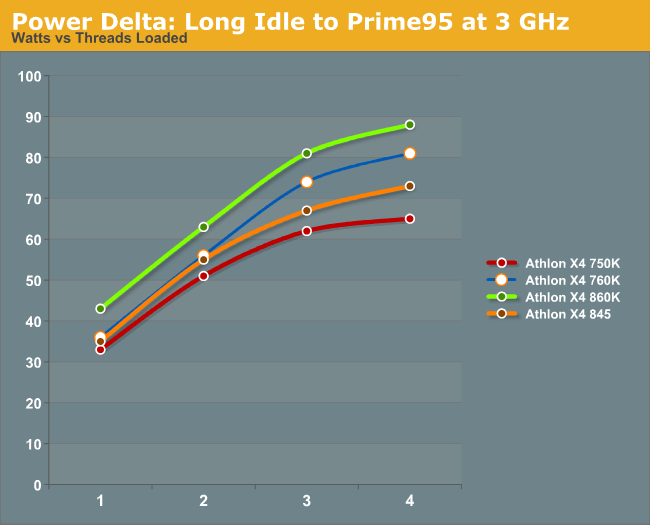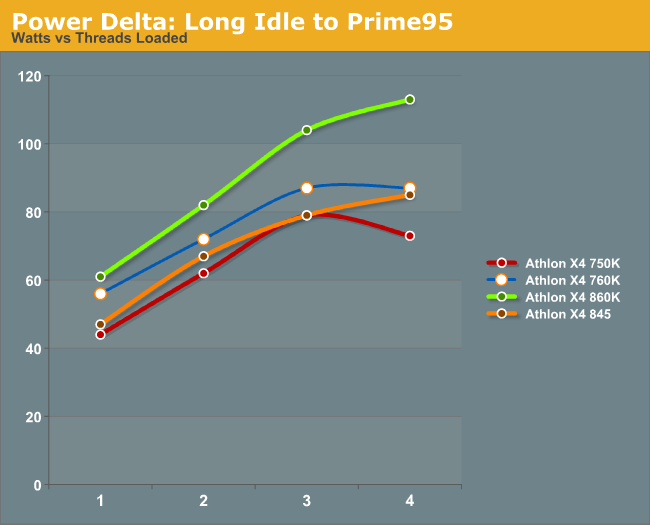AMD Carrizo Part 2: A Generational Deep Dive into the Athlon X4 845 at $70
by Ian Cutress on July 14, 2016 9:00 AM ESTPower Consumption
Power consumption was tested on the system while in a single MSI GTX 770 Lightning configuration with a wall meter connected to the power supply. This power supply is 80PLUS rated, and as I am in the UK on a 230-240 V supply, leads to ~75% efficiency > 50W, and 90%+ efficiency at 250W, suitable for both idle and multi-GPU loading. This method of power reading allows us to compare the power management of the UEFI and the board to supply components with power under load, and includes typical PSU losses due to efficiency.
Our Power Consumption tests have changed slightly since our last review as we are testing out new ways to represent the power used by the CPU and the system. The current three standard tests start with a system at long idle, meaning that the OS turns off the monitor and enters a lower power state without going into S3. We then move into a standard idle state on the desktop, with no software running but the desktop on display. The system is then moved into high performance mode, and we run a one-minute OCCT test to identify peak power consumption.
Due to extended requests, our power consumption numbers also use Prime95 to load the system. We use Prime95's peak power consumption mode, testing 1/2/3/4 thread consumption at the wall with our power meter. P95 hits the peak power relatively quickly, making this a straightforward test to include. For CPUs above 4 threads, we typically manage powers of two, half the CPU, and the full CPU to get an accurate picture.
For this review, we performed the power analysis for all four main CPUs at the 3 GHz frequency (using automatic voltage on the motherboard), as well as at stock frequencies. The values shown are delta values to the long idle power consumption, due to power delivery variations.
Generational Power Consumption at 3 GHz
All four processors have a 2-3W difference moving from a long idle to an idle state, however it is clear that our Carrizo CPU, which we stated is well outside its normal efficiency window at the beginning of this review, has a very good response during OCCT loading.

These results are within 3-4W of the full loading provided by Prime95 as well. If we analyze the per core jumps from moving up the threads using Prime95, there are some interesting numbers to pick out.

All the processors increase their power consumption by ~20W when both modules are loaded, when moving from 1 core loading to 2 core loading. When moving to 3/4 core loading, it is obvious that as both modules are already running at high frequency, a smaller amount of power is needed for each to enable the second thread.
Power Consumption at Stock
For those keeping track, we were not able to source identical TDP rated processors for this test. While the Carrizo based Athlon is 65W, the other processors are at the 95W/100W level. This makes total power consumption numbers relatively processional, and it becomes interesting looking into how close each processor gets to its TDP.
In our testing, the X4 845 seems to go beyond its 65W TDP, pushing almost another 9W through our power meter. This is only 8W away from the X4 750K, which should be 35W ahead. However, it would seem that for the X4 845, P95 draws an extra 15W compared to OCCT, but for the X4 750K, it draws 10W less, showing how difficult it can be to retain consistency. It is worth noting that TDP ratings are difficult to interpret in this way - the processors coming out of the fabs will have a statistical variation to their operating voltage, and this differs between samples. A good sample of a high TDP compared to a bad sample of a low TDP might seem to generate an interesting story, however without having access to several dozen units it can be strained to draw many conclusions.

Looking at the Prime95 core-loading numbers, we see a similar pattern to what happened at 3 GHz, despite the X4 760K getting the same power reading for 3/4 core loading and the X4 750K actually decreasing in power with four loaded threads.










131 Comments
View All Comments
aryonoco - Friday, July 15, 2016 - link
Oh great, another AMD Bulldozer CPU, on 28nm, in 2016.I can't even begin to pretend to be enthusiastic about this.
The only people who will buy this are internet cafe/game centres in developing countries; none of whom care about AT says. I wonder why Ian thought he should spend so much time thoroughly reviewing a part that not one of AT's readers will ever buy.
Cryio - Friday, July 15, 2016 - link
To be fair this is an architecture from 2015 brought to desktops half-hearted and it wasn't released for any good reason IMO.Given the improvements Kaveri and Carizzo pose over the previous generations most of the time, if AMD would have released FX CPUs based on Stream Roller and Excavator, we would've got some interesting CPUs.
kondor999 - Friday, July 15, 2016 - link
Oh look, another shitty, hot, antiquated AMD CPU that only (gosh, I can't actually think of anyone) would buy.I really wish they'd get their act together. Not necessarily because I'd buy their products, but just to force Intel into giving us more than a 3% (or so) IPC iterative improvement.
TheinsanegamerN - Friday, July 15, 2016 - link
So, if you only want AMD to be competitive so that intel is more competitive, how do you expect them to do that when nobody buys their stuff? R and D needs money.silverblue - Friday, July 15, 2016 - link
Though temperature readings appear to be a bit hard to come by, the 845 appears to idle at 26 degrees and full load on AIDA64 at 40 degrees which puts it below anything else AMD has, making it comparable to the Pentium G3220 (though the former does have a better cooling solution).Source: http://www.eteknix.com/amd-athlon-x4-845-carrizo-p...
It's up to you whether you want to believe that or not.
Meteor2 - Saturday, July 16, 2016 - link
I don't think there's more than 3℅ IPC increase annually available. Apple, ARM, Qualcomm and Intel all seem to be converging at any given power.zodiacfml - Friday, July 15, 2016 - link
Waste of time. Yes, it competes with the Pentium, but the Intel chip has integrated graphics which could be useful whether the user has a graphics card or not. Paying more for less.Talking about Zen, it will just compete with Haswell generation chips. Intel knew this which is why their tick-tock strategy has slowed down.
cocochanel - Friday, July 15, 2016 - link
Intel didn't slow down because of AMD. It's because of x86. It's harder and harder even for mighty Intel engineers to squeeze more performance from an antiquated ISA. The fact that Zen took so long to get here it's a clear indication of the same.TheinsanegamerN - Monday, July 18, 2016 - link
There is no clear indicationAMD has far fewer resources then intel does, so it makes sense it would take them much longer to make a new CPU arch then intel.
Intel isnt making any advancements because they have no competition. There may be more performance sitting in their arch they are not using, since there really is no reason to.
Lolimaster - Saturday, July 16, 2016 - link
Carrizo totally gimped by l2 cache.The problem is that Bristol Ridge comes with the same pathetic 2MB for their 4 cores APU.